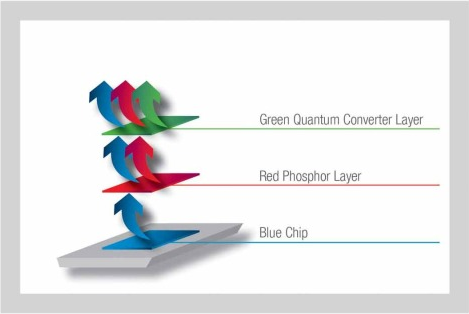Just when I had convinced myself that quantum dots were THE answer for allowing LCD to compete with OLED image quality, it seems it may only be one of several answers.

At their suite at the Westgate Hotel during CES 2016, executives of StoreDot (Herzeliya, Israel) showed me their MolecuLED — an organic color conversion layer that StoreDot says is an alternative to quantum dots. Although VP of R&D Daniel Aronov and Director of Product Marketing and IP Guy Paradis would not talk about molecular or structural details, they were very happy to talk about MolecuLED’s performance, comparing it to the QD solutions in a prior model of the Kindle HD and Samsung’s solution in an unidentified product.
StoreDot’s organic film has peaks at wavelengths very close to that of the Kindle and Samsung solutions, and with similar sharpness of emission peaks, using the standard measure of full width at half maximum (FWHM). (See figure.) Lifetime will be equivalent by the middle of this year, Aronov said.
Aronov said that MolecuLED can be made with a simple, high-yield manufacturing process at a cost approximately 30% lower than QD films. Predictably, he also pointed out that the product is free of heavy metals.
The company was using CES to initiate an aggressive partner engagement process. It was meeting potential partners at CES, with plans to invite prospects to test MolecuLED during Q1 and Q2, and the firm plans to sign commercial agreements with from one to three partners in Q3-Q4.
 Other approaches, including new twists on quantum dots, are also in process. Osram issued a press release prior to CES briefly describing a an approach it calls Quantum Colors, in which a red phosphor layer and a green quantum-well converter layer are deposited directly on a blue LED chip, and the company then refused to give much additional information on this very interesting approach. (Osram Offers LEDs with QD Boost (Updated 3/12/15 – subscription required) Osram put out a press release, which can be found on its website. Such an approach is very attractive for full-matrix backlighting, in that it removes the need for a separate quantum-dot film and potentially uses much less material.
Other approaches, including new twists on quantum dots, are also in process. Osram issued a press release prior to CES briefly describing a an approach it calls Quantum Colors, in which a red phosphor layer and a green quantum-well converter layer are deposited directly on a blue LED chip, and the company then refused to give much additional information on this very interesting approach. (Osram Offers LEDs with QD Boost (Updated 3/12/15 – subscription required) Osram put out a press release, which can be found on its website. Such an approach is very attractive for full-matrix backlighting, in that it removes the need for a separate quantum-dot film and potentially uses much less material.
The release quotes Peter Lenz, product marketing for Osram Opto Semiconductors, as saying the technology can deliver 100% of DCI and over 80% of Rec. 2020. Currently, 100% of DCI is a very reasonable gamut for premium commercial TV, but cadmium quantum dots currently deliver 90+% of Rec. 2020. So Quantum Colors is not the maximum-performance solution, although it should be an economical one. In fact, Lenz addressed that in detail: “For a 55-inch Ultra HD TV with 100 percent DCI coverage the complete cost of the light source can be as low as 55 euros based on our Quantum Colors technology. The cost of just the quantum dot sheets in existing solutions is twice as high.” Osram says initial customer projects are in progress, and will be ready for mass market implementation by the end of this year.
The general concept of putting color converters right on the LED chip is not a new one, but quantum dots age more rapidly when they are placed directly on the chip and subjected to high heat and luminous flux. QD Vision says its dot formulation is more resistant to heat and flux than its competitors, but still not ready for commercial QD-on-chip implementations. However, you can expect an very interesting announcement about a new approach from QD Vision, perhaps by the time of SID Display Week. – Ken Werner
Ken Werner is Principal of Nutmeg Consultants, specializing in the display industry, manufacturing, technology, and applications, including mobile devices and television. He consults for attorneys, investment analysts, and companies using displays in their products. You can reach him at [email protected].

